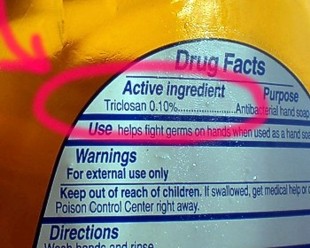Avon Phasing Out Antibacterial Chemical Over Concerns of Potential Adverse Health Effects
 June 24, 2014
June 24, 2014  Kyriaki (Sandy) Venetis
Kyriaki (Sandy) Venetis Avon is the latest company to begin phasing out the antibacterial chemical triclosan from its products because of increasing public concerns about its risks to human health and increasing evidence that antibacterial products are no more effective in killing germs than traditional methods like plain soap and water.
 Photo courtesy of business-ethics.com.
Photo courtesy of business-ethics.com.
Triclosan is an active antimicrobial ingredient contained in a variety of personal care products – including toothpastes, face washes, soaps, and deodorants – where it acts to “slow or stop the growth of bacteria, fungi, and mildew,” says the U.S. Environmental Protection Agency.
Triclosan is a chemical also commonly found in other consumer products, including clothes, kitchenware, furniture, carpeting, toys, caulking compounds, and sealants. It’s also used for industrial purposes as an antimicrobial pesticide in equipment including conveyer belts, fire hoses, dye bath vats, and ice-making equipment.
Among the biggest health concerns for people though still comes from the chemical being incorporated in personal care products, where increasing evidence shows that the risks outweigh any potential benefits.
Looking at antibacterial chemicals in soaps, Colleen Rogers, a microbiologist with the U.S. Food and Drug Administration, said in a reported last December that “there currently is no evidence that over-the-counter antibacterial soap products are any more effective at preventing illnesses.”
The FDA report said that, “There are indications that certain ingredients in these soaps may contribute to bacterial resistance to antibiotics, and may have unanticipated hormone effects.”
The agency report continued that, “Animal studies have shown that triclosan may alter the way hormones work in the body,” adding that, “While data showing effects in animals don’t always predict effects in human, these studies are of concern to the FDA. In addition, laboratory studies have raised the possibility that triclosan contributes to making bacteria resistant to antibiotics.”
The agency is also concerned that, “Such resistance can have a significant impact on the effectiveness of medical treatments.”
In addition, the Campaign for Safe Cosmetics reported that, “Since 2000, a number of studies have found microorganisms that are resistant to triclosan. For instance, triclosan-resistant strains of microorganisms such as E. coli and salmonella have been identified.”
Those most vulnerable to the health risks associated with triclosan are pregnant women and their fetuses as well as breast-feeding mothers and their new-borns.
The Campaign for Safe Cosmetics explains that triclosan is a lipophilic, meaning that it accumulates in fatty tissues, and adding that, “Studies have found concentrations of triclosan in three out of five human milk samples. Triclosan has also been found in the umbilical cord blood of infants.”
The consumer advocacy grouped also said that, “These results raise concerns for the fetus during vulnerable periods of development, and make the bioaccumulative and endocrine-disruptive potential of triclosan even more alarming.”
The Campaign for Safe Cosmetics also expressed concern for the environment, saying that, “Since the majority of the products that contain triclosan are eventually washed down consumers’ drains, high levels of triclosan are accumulating in water systems and negatively impacting the environment.
“Triclosan is toxic to algae and there is evidence that triclosan is accumulating at high levels in fish and other aquatic life.”
The U.S. Environmental Protection Agency said that based on monitoring data, triclosan was has been found in approximately 36 U.S. streams originating from sludge water treatment plans, trickle-down filtration, and sewage overflows into open water.
While the EPA isn’t very concerned about the output of triclosan into the environment from consumer products, saying it’s “unlikely to contribute significant quantities” into the environment, the agency is concerned about the chemical’s output from industrial sources.
The EPA said that because it’s unknown how much triclosan is released from industrial sites, where it’s incorporated into plastic and textile items, the agency is requiring users to perform environmental water monitoring.
In addition, the EPA is requiring industrial users to add labeling statements indicating that triclosan is toxic to fish and other aquatic animals, and that any discharges into waterways need to conform to the requirements of the National Pollutant Discharge Elimination System (NRDES).
With all of the concerns expressed in the media, a number of other personal care companies, including Proctor & Gamble and Johnson & Johnson, have begun phasing out triclosan from their products, though still claiming they believe the chemical is safe, but are phasing it out because of respect for consumers’ concerns.
Related GreenVitals Article
Additional Resources
- U.S. Food and Drug Administration - Triclosan: What Consumers Should Know
- U.S. Environmental Protection Agency – Triclosan Facts
- Environmental Working Group’s Deep Skin Cosmetics Database – Triclosan
Reader comments and input are always welcomed!
 bath products,
bath products,  facial products,
facial products,  soap | tagged
soap | tagged  bath products,
bath products,  personal care products,
personal care products,  triclosan
triclosan 
Reader Comments